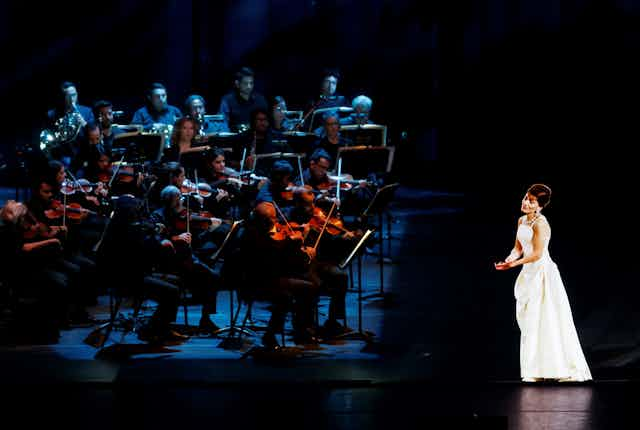I was recently among a curious Melbourne audience who turned out to see a hologram of the long-dead soprano Maria Callas singing with the Melbourne Symphony Orchestra.
The stage was moodily lit, with 30 musicians in shadows. Loud reverberating footsteps foreshadowed Callas’ entrance and indicated potential humanness. When she eventually appeared centre stage, the audience gasped. Ripples of laughter followed when she and conductor Daniel Schlosberg played out a manufactured exchange of acknowledgement.
The Callas hits were performed, from Bellini’s Casta Diva from Norma to Bizet’s L'amour est un oiseau rebelle from Carmen. But there were limitations to the success. While the live orchestral sounds filled Hamer Hall, the vocals were clearly directed from the speakers, rather than the hologram at centre stage.
I felt an uncomfortable silence lingering before and after each song. The Callas hologram delayed the momentum. She bowed, inviting the audience to clap again, and coyly berated the conductor when he started before she was ready. The audience waited, and it all seemed to drag on.
This is one of the limitations of combining live music and a pre-recorded voice: you can’t respond to the temperament of the audience. You can’t speed it up when required.
Those seated around me did not seem to share my concerns. A version of Callas – the woman known as La Divina, “the divine one” – had been digitally resurrected, and that was enough for now.
Hologram performances across the world
The audience was never fooled by the technology. Instead, they were awe-struck. A phrase I heard murmured over and over was: “how do they do it?”.
“They” are BASE Xperiential, an American media company which also created Roy Orbison, Buddy Holly and Whitney Houston holograms.
But the “how” part of the question can be complex. In simple terms, holograms are created when laser lights project a 3D video of a person onto a transparent yet reflective surface, such as a screen. The projected figure lip-syncs to existing vocal recordings, and the live musicians play along.
This is not a unique phenomenon.
Callas in Concert has been performed across the world since 2018. Tupac performed beyond the grave at Coachella in 2012. Elvis Presley duetted posthumously with Celine Dion in front of a studio audience for American Idol in 2007. A hologram of the beloved Taiwanese superstar Teresa Teng recently toured Asia.
Artists who are still living are also creating hologram concerts. Performance-shy ABBA can now get back on stage via avatars of their 1979 selves for their lucrative show Voyage. Earlier this month, KISS wound up their final live tour and announced they “have been immortalised and reborn as avatars to rock forever” in digital form.
Read more: Abba and Tupac in the metaverse: how digital avatars could be the bankable future of band touring
A living legacy
Are hologram concerts a good thing? They are for performers. Possibly.
A hologram can continue to tour long after a singer’s physical body has expired. It keeps them in the public imagination – after all, a star’s image is contingent upon public awareness – and continues to be a lucrative source of income for the copyright holder.
Unlike people, holograms can be in many places at the one time, and aren’t restricted by travel. Artists can perform with their holographic peers such as Coldplay’s 2021 collaboration with BTW holograms for their single My Universe on The Voice finale.
For audiences, the benefits are significant.
As the brother of Teresa Teng noted, hologram performances are also moments of nostalgia for those who want just one more gig.
A hologram performance might be the only way you can see a performer who died before you were born, or see a star who never toured Australia, or see a dream line-up of artists who never performed together.
But audience reactions are mixed.
I conducted a study with a colleague from the Kyoto University of the Arts, asking Japanese audiences their responses to AI Hibari, an AI deep learning hologram of Misora Hibari, who died in 1986.
This hologram replicated her fashion style, musical timing, unique vocal techniques and performance gestures, and performed several songs the real Hibari never did, including Let it Go from Frozen.
While some audience members at the Tokyo performances were visibly moved to tears, others said the hologram was “profaning the dead”, manipulating the memory of the real Hibari, and posing an existential threat to the live music industry.
Where to next?
Audiences have high expectations for digital images. Poor-quality holograms fall into the “uncanny valley” – that point when we feel revulsion because they are not quite human.
We’re sceptical about how the images of the dead are used. They have no say or recourse of action. What if Maria Callas never wanted to be performing as a hologram decades after her death?
We’re cynical about greedy copyright holders and gatekeepers in the music industry. Who is making the money from hologram performances? In death, control and power have shifted away from the singer.
And we’re worried about overreach. The enormous progress of AI and the growing public acceptance of virtual singers means more hologram performances will grace our concert halls. And they will be singing songs that they never performed when they were alive.
Holograms have been around for a long time, and I think they are here to stay in spite of these ethical dilemmas. Even though holograms are inherently gimmicky, inquisitive audiences will still flock to see the latest technological developments in music performance. And judging from the appreciative crowd at the Callas concert, the thrill of seeing La Divina again overrides any human concerns.
Read more: Holograms and AI can bring performers back from the dead – but will the fans keep buying it?

